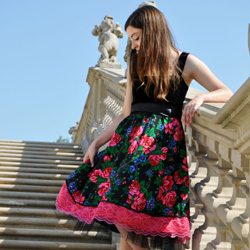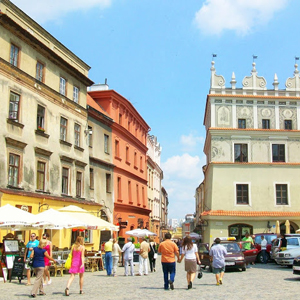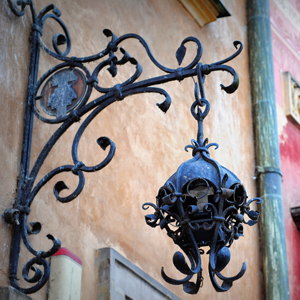Seven kilts.
Three pirates, one with a stuffed monkey on his shoulder.
Four velvet capes.
One Robin Hood.
Two top hats.
And 30 maidens.
That’s what I see in the first hour of Maryland’s 34th Annual Renaissance Festival. I also count three animal tails. “Prepare Thyself for Merriment,” reads the sign above the entrance.
Indeed.
Located in Crownsville, Md., the festival bills itself as a “recreation of a 16th century English village” called Revel Grove. Ministry sang that everyday was Halloween in the 1980s. In Revel Grove, every weekend from late August through late October is Festival Day, complete with visits from King Henry VIII and his court.
We enter just after 2 p.m. I don’t see the king yet, but I do see a banners for Steak on a Stake and Rapunzel’s Hair Braiding.
Led Zeppelin’s “Kashmir” is playing somewhere on medieval-sounding instruments. There’s bright yellow straw on the ground and the requisite Maypole with orange and blue ribbons. A costumed Robin Hood walks by. “Good morrow,” he says in a rather unconvincing British accent.
“This is like Renaissance Fair universe,” says one of my friends. “Every other Ren Fair I’ve been to has just been booths.”
This one is definitely more than booths. The 25-acre site is jammed full with food stalls and craft shops, games and performances ranging from a single guy in a jester hat doing card tricks to a jousting tournament with decked-out knights on horses galloping around a sandy arena.
According to its website, the festival brings in a daily average of 14,700 customers.
Some visitors dress up. Costumes range from simple flower wreaths to elaborate recreations of Renaissance clothing. Which means lots of velvet leggings on the gentlemen and lots of corset / long skirt ensembles on the ladies. But the definition of what constitutes Renaissance gear is quite loose: I also see a young man dressed as a fairy, complete with green wings and tutu, and more than one bondage costume.
Our group slowly makes its way down one of the festival streets. I’m snapping pictures when I run into a group of four men, who stop to pose. They’re fully costumed, eager to chat. Three introduce themselves as Robert, Robert and Stophe. The fourth doesn’t give his name but says he hopes I don’t mind him saying so, but I would “fill out” a costume nicely.
I turn back to the Roberts. They tell me they’ve been attending the festival for “8 to 10 years.” I ask what they do in their lives outside the fair.
“We’re professionals.” What kind? I ask.
“Professional enough,” they say. They giggle, then add that one’s an architect and the other’s a web developer.
“But here, I can be the biggest geek in the world,” Robert One says.
Robert Two says that at the festival, you can step outside of yourself, and “everyone is in on the joke.”
The Roberts say they decided to “go upscale” with their costumes this year, which they describe as hetero-flexible upper class nobles. They say they’ve been stepping up their costumes each year.
“He’s got a linen partlet with silver trim,” Robert One jealously says of Robert Two, adding that he hopes to someday attain that level of costume detail. A partlet, for those of you who like me, need a definition is, a 16th century chemisette with a band or collar, says Merriam-Webster. And a chemisette, in turn, is a woman’s garment; especially: one (as of lace) to fill the open front of a dress.
Moving on.
I ask No-Name Costume Filler about his costume. He says his black velvet tights are quite comfortable, and tells me to feel free to touch them, because the velvet grain “encourages upward movement.” The Roberts take this opportunity to try and tell me about their codpieces, but are thankfully interrupted by Stophe, who holds out a wine bag covered in fur and invites me to take a swig.
My friends, who have been giggling on the sidelines the entire time I’ve been chatting with The Four, think this is hilarious, and helpfully offer to hold my camera, notebook and pen. One even takes off my scarf to guard against wine bag skills.
I gingerly take the bag. It’s furry. I uncork it. My friends are taking pictures and we’ve now attracted a small crowd. I try to say something about how a journalist should never become part of the story, journalistic integrity, ethics etc., but my protests are drowned out by laughter and clapping and clicking shutters. I take a tiny swig to general applause, hand the wine sack over to another friend, and retrieve my scarf, camera, notebook and pen.
Stophe, WineSack Man, is not wearing a shirt. His costume is black, baggy, knee-length pants, red-and-black striped tights, and black forearm gauntlets. “I’m a Welsh headsman,” he says. “I take the heads off.” It’s his third time at the fair.
“I like being someone who I’m not,” he says, adding that the fair is a place where people can connect on a different level than in everyday life.
He’s on his way to get his freshly applied henna tattoo spritzed so that it sets better, and I follow him there. The spritzer is Chris, 16, from Baltimore. He says he’s worked at the fair for two years. His first visit was four years ago and he’s wanted to work at the festival since then. He’s wearing a light blue smock, leather vest and jeans. He tells me that his mother and sister also work at the fair. They’re part of the more than 600 people who work at the festival each season.
Chris turns to help a customer. When he finishes, he comes up to me and extends his hand. “I’m sorry I didn’t say goodbye earlier,” he says politely.
I next stumble onto a scene being acted by some of the fair’s paid performers. There’s a queen in a bright red dress, and she’s asking the audience if she should marry for love or money. Most shout, Love! but the queen wrings her hands and looks distressed.
I pass vendors selling pretzels, pickles and cinnamon roasted almonds, as well as lots of food on a stick: “Mac and cheese on a stick!” I overhear a man exclaim to his female companion. “Yeah, babe,” she responds. There’s also Sausage on a Stick, the aforementioned Steak on a Stake, and Cheesecake on a Stick.
I continue wandering, passing by booths where you can “Dunk A Wench,” throw axes at a target, and scale an elaborate rock-climbing wall shaped like a castle. A Celtic band, dressed in red-and-black kilts and boots, plays bagpipes, drums and a fiddle to an appreciative crowd.
When I rendezvous back with my group near the end of the day, we compare notes. “It was awesome! ‘Cuz look at this!” says Tim, who’s strapped a long play sword and play knife via a rope belt to his waist. The main – and only – complaint is the lack of running water. There are containers with hand sanitizer by all the portable toilets (marked: “Privies”).
The same Led Zeppelin is playing as we near the exit, but it’s softer now. Slower.
“May your carriages take you home safely,” we’re told as we leave the park. Walking to our car, we see two elephants being led down a path.
CR



